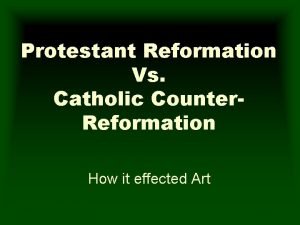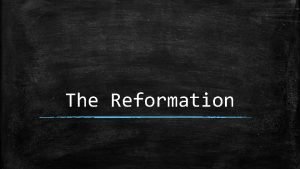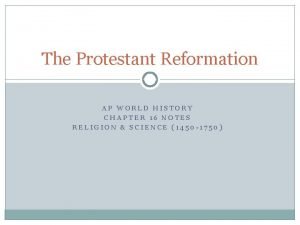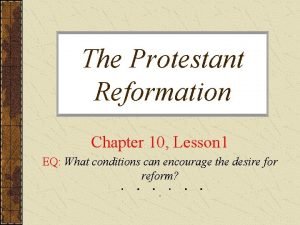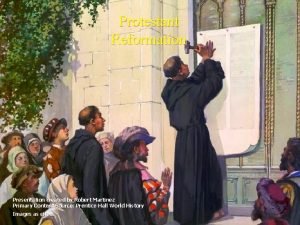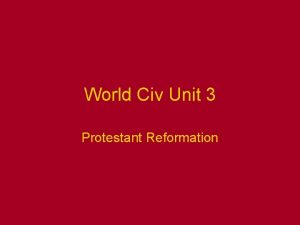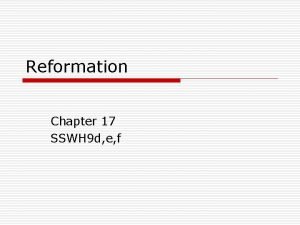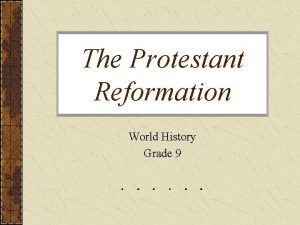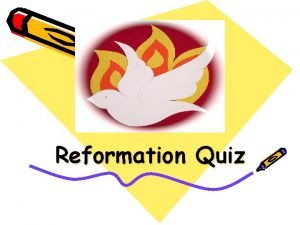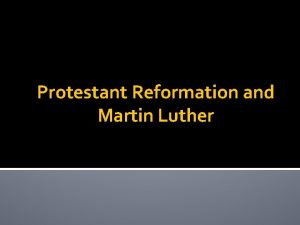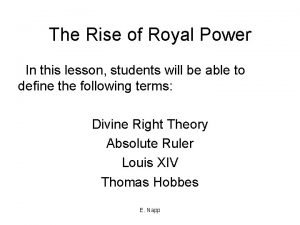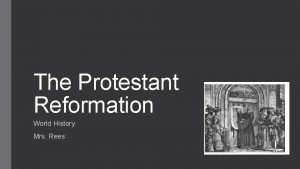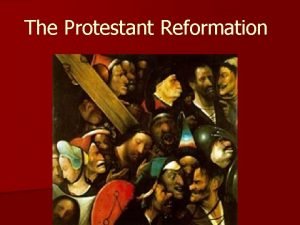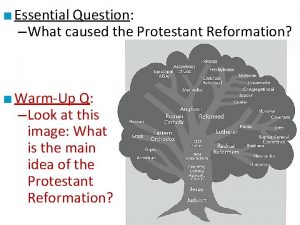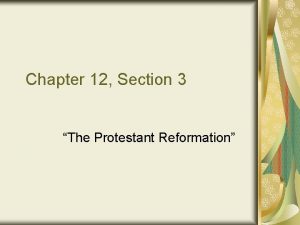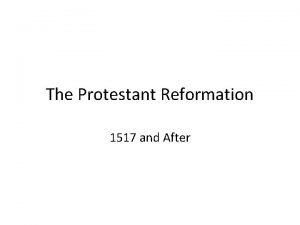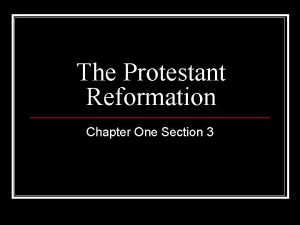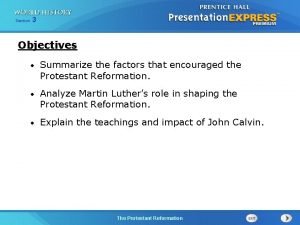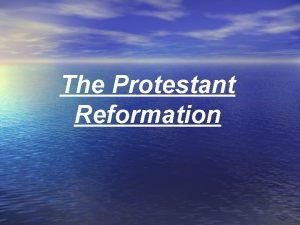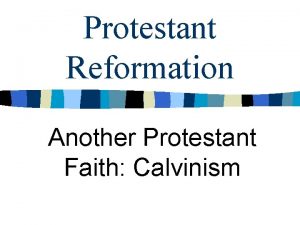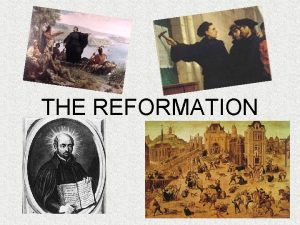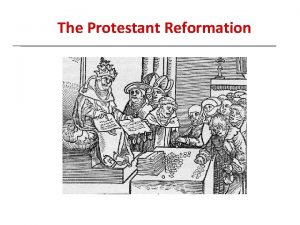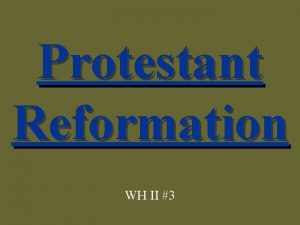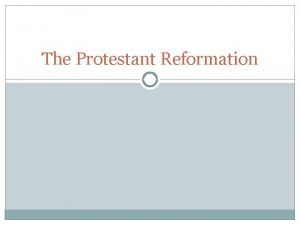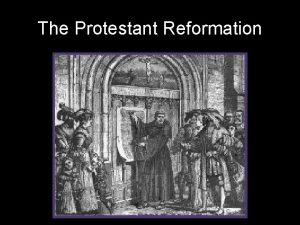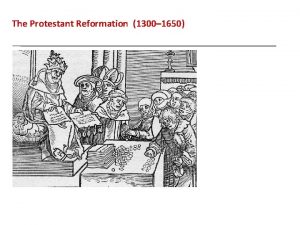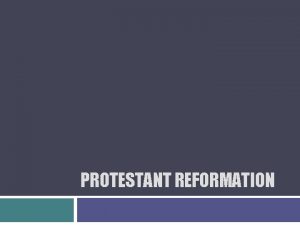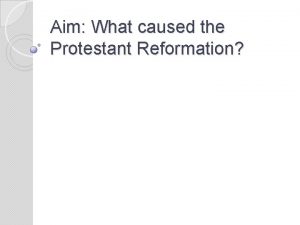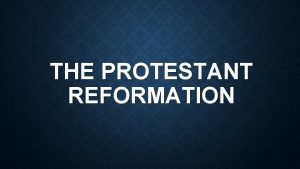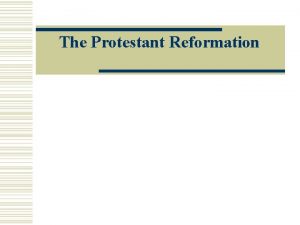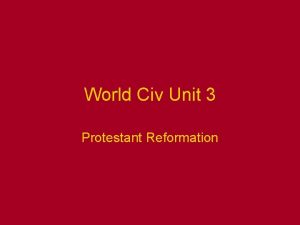The Protestant Reformation What is the Protestant Reformation


















- Slides: 18

The Protestant Reformation

What is the Protestant Reformation? Protestant Reformation- a religious movement in the 1500’s that split the Christian church in western Europe and led to the establishment of many new churches. – People grew displeased with the church’s… • Financial Corruption • Abuse of Power • Doctrinal Inconsistency

Breakdown of Denominations

Early Reformers John Wycliffe (1324 -1384) – Believed clergy had too much wealth and power. – People should be able to interpret and read the Bible on their own. – Translated the Bible into English; declared a heretic. – Lived during Western Schism (more than one pope). • This caused questioning about Papal Authority.

Early Reformers Cont… Jan Hus (1369 -1415) – Said Christ was the head of the Church, not the pope. – Bishops should be elected by Church councils rather than appointed by the Pope. – At the Council of Constance, he made his case, but he was burned at the stake for his beliefs. – Spiritual leader of the Moravian Church.

Early Reformers Cont… Erasmus (1466 -1536) – “Erasmus laid the egg that Luther hatched. ” – Was concerned by the abuses of power and doctrinal issues within the Catholic Church. – Erasmus remained committed to reforming the Church from within and supported the authority of the Pope. – Wanted a “middle road” between traditional faith and practice, and reform. – He also held to Catholic doctrines such as that of free will. • Rejected protestant ideas of salvation through faith alone, and predestination.

What happens to spark the Reformation? Pope Leo X needs money to build St. Peter’s Basilica…so he sells indulgences! – Indulgences- pardons issued by the pope that people could buy to reduce a soul’s time in purgatory = (People could buy forgiveness)

Language Barriers Most uneducated people didn’t understand Latin, but knew the local common language or “vernacular”. – Almost all Bibles were written in LATIN before the Reformation. It was the job of the church clergy to translate the Bible to lay people. Reformers who could read Latin began to realize that the clergy were teaching messages that didn’t agree with the Bible.

Martin Luther was a German monk and professor of theology (religion) at the University of Wittenberg. One of the many leaders of the Protestant Reformation. – Luther objected to a saying attributed to Johann Tetzel that "As soon as the coin in the coffer rings, the soul from purgatory springs. "

Luther’s 95 Theses In 1517, the 95 Theses were nailed to a church door. They were written in Latin. – Luther’s intention: NOT TO BREAK WITH CHURCH, BUT REFORM IT! – Criticized: 1. Indulgences 2. Power of Pope 3. Wealth of Church God’s Grace won by FAITH ALONE! Printing press spreads 95 Theses throughout Europe

Excommunication In 1520 Pope Leo X excommunicated Luther. – Holy Roman Emperor Charles V passed measures to suppress Luther’s writings. – Luther relocates to Germany, where he is welcomed by the local princes (who are frustrated with the Church’s influence in politics) – Lutheran princes in Germany issued a protestatio or protest. • Hence the term Protestant!

Other Reformations Ulrich Zwingli in Switzerland – Theocracy • A government in which church and state are joined and in which officials are considered to be divinely inspired. John Calvin in Switzerland – Predestination • God knows who will be saved, even before people are born, and therefore guides the lives of those destined for salvation. John Knox in Scotland – Laid grounds for Presbyterian Church

In England, the Reformation began with the King! King Henry VIII – He wants a SON!. – First wife has a daughter, Henry wants a divorce – Divorce is not permitted by Catholic church, and when the church refuses to grant Henry an exception, he breaks from the Church and forms his own church, the Church of England. – Same as catholic church except for two things • 1) They allow divorce • 2) King is head of church rather than pope

The Reformation Parliament had to approve the King’s decision to break with the Church Parliament met from 1529 -1536, gradually passing laws that reduced Catholic power in England – – – 1529: Legal privileges of clergy revoked 1530: Pope’s legal authority denied 1532: Sending tithes to Rome forbidden 1533: All legal/religious appeals to Rome forbidden 1534: Act of Succession—Declares Henry’s marriage invalid – 1534: Act of Supremacy—Declares King head of the Church, and requires all subjects to swear allegiance to the Church of England (punishable by death)


Longstanding Effects of Henry VIII Had 10 children, but only 3 survived past childhood – Edward (son of Jane Seymour) • Becomes King of England at the age of 10 (1547), dies 6 years later. – Queen Mary I or “Bloody Mary” (daughter of Catherine of Aragon) • Became Queen in 1553, died in 1558 • Raised Catholic; she reestablished the Catholic Church in England. • She killed many protestants and had approximately 300 heretics burned at the stake.

Elizabethan England Queen Elizabeth I (daughter of Anne Boleyn) – Imprisoned during the reign of Queen Mary – Rules from 1558 -1603 – Permanently returned England to Protestantism – Never married or had children (nicknamed the “Virgin Queen”) – England enjoyed good fortune during her reign, making her very popular. – Many of Shakespeare’s plays were written specifically for Queen Elizabeth, who loved theater.

Protestant Reformation Summary Due to various issues with the Catholic Church, reformers began challenging church authority in the early 1500 s. The reformation spread quickly thanks to the printing press. This led to the creation of many new churches (Lutheran, Presbyterian, Calvinist, etc. ) In England, the Henry VIII broke with the Catholic church to secure a divorce. England went back and forth between Catholic and Protestant during the 1500 s, until becoming permanently protestant under Queen Elizabeth.
 Protestants vs catholic
Protestants vs catholic Protestant reformation kahoot
Protestant reformation kahoot Reformation ap world history
Reformation ap world history Lesson 1 the protestant reformation
Lesson 1 the protestant reformation Unit 3: martin luther & the protestant reformation
Unit 3: martin luther & the protestant reformation Protestant reformation
Protestant reformation Protestant beliefs
Protestant beliefs Reformation def
Reformation def Crash course protestant reformation
Crash course protestant reformation Protestant reformation quiz
Protestant reformation quiz Martin luther reformation political cartoon
Martin luther reformation political cartoon Protestant reformation
Protestant reformation 95 theses rap
95 theses rap The protestant reformation crossword puzzle
The protestant reformation crossword puzzle What caused the protestant reformation?
What caused the protestant reformation? Unit 12 lesson 3 the protestant reformation
Unit 12 lesson 3 the protestant reformation Protestant reformation map
Protestant reformation map Protestant reformation worksheet answer key
Protestant reformation worksheet answer key What factors encouraged the protestant reformation?
What factors encouraged the protestant reformation?
